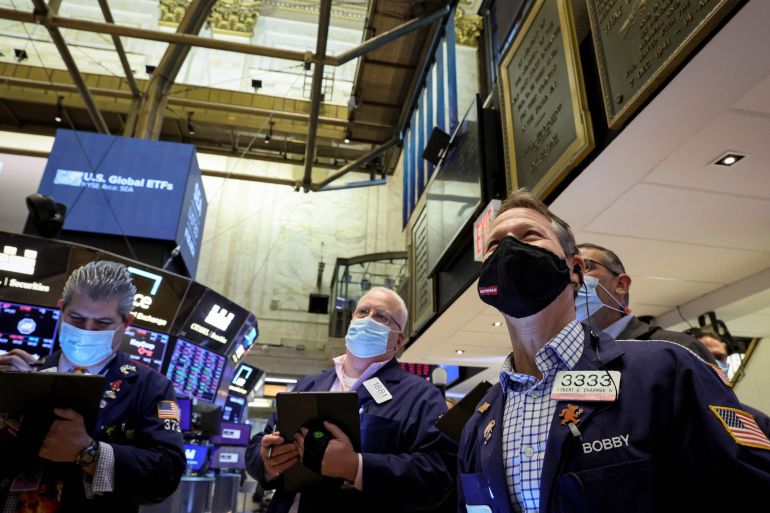US stocks come back to finish higher after volatile trading day
Markets were rattled by geopolitical tensions and the United States Federal Reserve’s campaign against inflation.

A stock selloff that at one point rivaled any of the last two years was all but wiped out as dip buyers emerged by Monday’s close, the latest breathtaking reversal in markets rattled by geopolitical tensions and the Federal Reserve’s campaign against inflation.
Retail, industrial and energy companies led a rebound in the S&P 500 into the close after the gauge tumbled as much as 4% earlier in the day. The dollar gained, while 10-year Treasuries were little changed.
Keep reading
list of 4 itemsJames Webb Space Telescope reaches final stop a million miles out
NATO sends reinforcements to Eastern Europe amid Russia tensions
Bitcoin rout sees $30,000 floor emerge as next line in the sand
Traders remain resolute in anticipating the Fed will plow on with increasing borrowing costs even as riskier assets tumble. Swap markets show a quarter-point hike in March and close to a full percentage point rise for the whole of 2022. Morgan Stanley’s Michael Wilson said January’s equity rout “fits nicely” with his so-called fire and ice narrative, according to which markets were set for a drawdown amid tighter policy and decelerating economic growth. In anything, the retreat has further to go as “winter is here” for stocks, he wrote.
“There’s certainly a lot on the table this week, and I think the market behavior and all of these risks that they’re facing really is testing the mettle of the long-term investor,” JoAnne Feeney, partner at Advisors Capital Management, told Bloomberg Television Monday.
Speculators who scrapped bullish bets on the dollar at the fastest pace in more than 18 months are now missing out on the currency’s rally ahead of the Fed decision on Wednesday. Net-long aggregate speculative positions versus major peers have dropped the most since June 2020, according to the latest data from the Commodity Futures Trading Commission.
U.S. President Joe Biden was set to hold a call with European leaders as western nations work to strike a unified position on Russia. The North Atlantic Treaty Organization said it would boost its deployments in eastern Europe in a bid to deter a new invasion in Ukraine. Russian President Vladimir Putin has denied he’s planning an attack.
For more market analysis, read our MLIV blog.
What to watch this week:
- IMF launches the World Economic Outlook update Tuesday.
- U.S. U.S. Conf. Board consumer confidence Tuesday.
- Fed monetary policy decision Wednesday.
- EIA crude oil inventory report Wednesday.
- U.S. new home sales, wholesale inventories Wednesday.
- South African Reserve Bank rate decision Thursday.
- U.S. initial jobless claims, durable goods, GDP Thursday.
- Eurozone economic confidence, consumer confidence Friday.
- U.S. consumer income, University of Michigan consumer sentiment Friday.
Some of the main moves in markets:
Stocks
- The S&P 500 rose 0.3% as of 4 p.m. New York time
- The Nasdaq 100 rose 0.5%
- The Dow Jones Industrial Average rose 0.3%
- The MSCI World index fell 0.7%
Currencies
- The Bloomberg Dollar Spot Index rose 0.3%
- The euro fell 0.2% to $1.1320
- The British pound fell 0.5% to $1.3484
- The Japanese yen fell 0.3% to 113.98 per dollar
Bonds
- The yield on 10-year Treasuries was little changed at 1.76%
- Germany’s 10-year yield declined four basis points to -0.11%
- Britain’s 10-year yield declined four basis points to 1.13%
Commodities
- West Texas Intermediate crude fell 1.6% to $83.79 a barrel
- Gold futures rose 0.6% to $1,844.40 an ounce